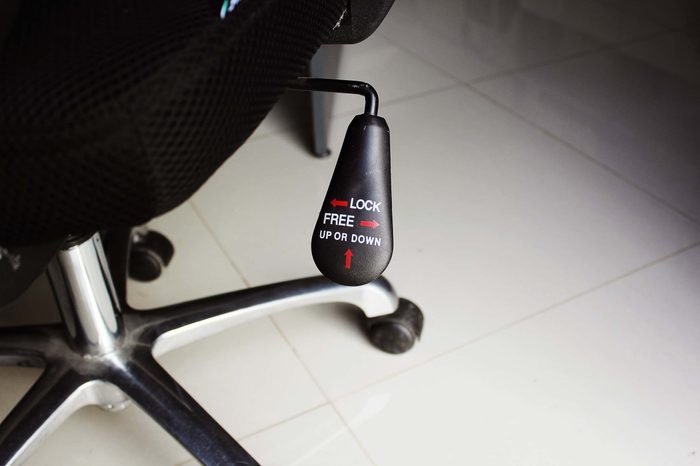Sitting at a desk all day is hard work
Some people consider going to their 9-to-5 a little bit painful—figuratively speaking, at least. But for many folks, their desk job leaves their shoulders, neck, and back in physical pain. And even if you’re among the lucky group that’s injury-free, if your gig requires you to be desk-bound, there’s a good chance painful symptoms are manifesting in the background. Scary, right? While that may seem a bit bleak, there are some simple ways desk jockeys can stay pain-free. Proper office ergonomics and tweaks to your daily routine, for example, can help you and your joints stay comfortable on—and off—the clock. Here are a few of the most effective techniques.

Adjust your desk and chair
Working four hours in a less than ideal position is like walking around all day with a rock in your shoe: it’s bound to leave you hurting. “When your desk and chair aren’t set up correctly, it puts the elbows, shoulders, and wrists into positions that apply force on the neck and upper back. It can also cause muscles to tighten up, which over time, can cause pain, explains Sapana Kanojia, MPT, of Orthology, a sports medicine and physical therapy practice that specializes in workplace and musculoskeletal injuries. To ensure a comfortable set up, the Occupational Safety and Health Administration suggests leaving clearance for your knees, thighs, and feet under the desk. If the desk is too low, place blocks under the legs to raise it up. If the desk is too high, raise your chair. If you’re unable to keep your shoes flat on the ground, invest in a footrest. As for your chair, it should support the curve of your spine and have armrests that can be set up so you can sit with your shoulders relaxed. Here are some ergonomically-friendly office chairs for back pain that will give you the support you need.

Move the monitor and mouse
Getting the placement of your chair and desk right is only half the battle. How you set up your keyboard and mouse, also influence how you’ll feel as the hours wear on, Kanojia says. “The screen should be an arm’s length away. If it’s too far away, your shoulder blades sit in a protracted position which puts force on the neck and inhibits correct contraction of the scapular muscles. It is important to keep those muscles strong because they help decrease tension in the neck—especially during sitting and computer use.” As for the height of the screen, it should sit so the top of the screen is slightly below eye level. Place your mouse close enough to your body so you can keep your wrists straight and your upper arms close to your body. (If you have shoulder blade pain, here’s what it could mean.)

Ditch the laptop
They may be less cumbersome than desktops, but laptops can be a pain in the neck—literally. “Laptops force the body into bad posture,” cautions Sam Berk, RPA-C, of Orthology. “If the laptop is situated for proper neck placement, the shoulders and wrists don’t sit correctly. And if the laptop is situated for proper arm ergonomics, which is most often, you’ll find yourself looking downwards and extending your neck.” Berk says this can lead to neck pain, headaches, rounded shoulders, shoulder pain, and even numbness that travels down the arms. If you must use a laptop, place books underneath it so that you don’t have to strain your neck to look at the screen. Since this set-up renders the built-in keyboard and track pad useless, you’ll need to hook up an external keyboard and mouse.

Pay attention to your posture
Even if your workstation is set up perfectly, you may still wind up in pain if you don’t pay attention to your posture. Be sure to sit up straight with your feet flat on the ground. “This position keeps the lumbar spine in a neutral position. It also distributes some body weight through the legs. This puts less stress and load on the spine and lowers the risk of muscles tightness,” Kanojia explains. (Check out these seven easy ways to improve your posture.)

Keep moving
If you sit at a desk all day, one of the worst things you can do is lounge around after you clock out. “People who don’t exercise regularly often have worse posture than those who do. This makes them more vulnerable to neck and low back pain,” Berk tells us. “I know it’s hard, but it’s so important to make time for exercise. Not only will it help ward off aches and pains associated with your desk job, but it can lessen stress and anxiety and improve overall health.” If you’re a fitness newbie, Berk suggests starting small—and try these tricks to get motivated. “Walk home from work or take a stroll during your lunch break. Or try doing some squats while brushing your teeth and stretch during TV commercials. And most importantly, find something you like to do whether that be walking your dog, taking a Zumba class, or hitting the gym with friends. “If you don’t enjoy it, you won’t stick to it,” Berk adds.

Keep a lacrosse ball at work
Walking to and from the water fountain and bathroom are great ways to add more activity to your day, but sometimes, staying glued to your chair for hours is inevitable. When that happens, consider a lacrosse ball your best friend. (You can get one on like this for $9.) “Grab a lacrosse ball and sit on it. This will help loosen up the muscles in the tush. Then, put the lacrosse ball on the wall and press your upper back against it,” Berk says. “As you roll side to side and up and down, you’ll release your traps and rhomboids, the major muscles of the upper back.” (Here’s how to help your body recover from a day of sitting.)

Tweak your diet
One study found that the more time women spent sitting, the more inflammation was present, according to the study in the American Journal of Preventative Medicine. (More inflammation = more pain.) Aside from moving more, one of the best ways to fight back is by eating a healthy diet rich in anti-inflammatory foods. Tomatoes, olive oil, green leafy vegetables, nuts, fatty fish, and berries, all fit the nutritional bill, say Harvard Medical School experts. On the flip side, things like refined carbs, fried foods, soda, red meat, and margarine promote inflammation, increasing your risk for pain.

Listen to your body
If you’re in pain, don’t wait to make an appointment with a doctor. And don’t just pop painkillers and hope for the best, either. If you’ve been experiencing pain for more than two or three weeks, the issue will likely not improve on its own. Not to mention, the longer you wait to seek help, the less effective treatment may be. A medical professional can suggest a regimen that will help you feel healthy again. So book an appointment. (These are the 24 secrets your pain doctor won’t tell you.)